
Anarchist Bombers and Other Revolutionaries in New York
The Wall Street Bombing and other
Anarchist Attacks in New York
New York City has been the home of radicals and radical movements. The anarchists who perpetrated a series of dynamite bombings during the first three decades of the 20th Century set off several of their bombs in the city, including one on Wall Street in 1920 that killed 38 people, seriously injured another 143, and temporarily shut down the stock exchange. Of course, bombs are dangerous even to their creators and users. Spectacular accidents by radicals have destroyed a few buildings and nearly killed Franklin Roosevelt over a decade before he was elected U.S. President. People in the 21st Century who say that things are dangerous now and they long for "the good old days" clearly don't know much about history. The anarchist bombings of roughly 1900-1930 led to pervasive government surveillance of domestic communication that continues today. Meanwhile, domestic terrorists continued to set off bombs in the city through the 1970s.
Not all the revolutionaries in New York have endangered the city. Leon Trotsky was one of the leaders of the Russian Revolution of 1917 and a founder and theorist of the Communist Party of the Soviet Union. He lived and worked in New York early in 1917. Then, in 1933, during the Great Depression, the Catholic Worker movement was founded on the Lower East Side.
Wall Street and Other Early 20th Century Domestic Bombings and Assassinations
For his time period, Trotsky was a relatively calm and quiet revolutionary. Anarchists and labor radicals perpetrated a wave of bombings and assassinations in the U.S. and around the world from the late 1890s through the early 1930s. The anarchist Gaetano Bresci had fatally shot King Umberto I of Italy on June 29, 1900, shocking and motivating the American anarchist movement. The worst of the bombings was a vehicle-borne shrapnel-packed bomb set off on Wall Street at noon on September 16, 1920. It killed 38 people and seriously injured 143 others. But before that...
Dynamite Assassination of Former Idaho Governor Frank Steunenberg, 30 December 1905
Frank Steunenberg was the 4th governor of the state of Idaho, serving 1897-1901. Nearly five years after leaving office he was assassinated by a dynamite bomb, making him the first victim of dynamite assassination by most reckonings.
Steunenberg was nominated as both the Democratic and Populist candidate for governor in 1896 with labor union support. He was elected as the first non-Republican governor of Idaho.
His years in office were marked by significant labor unrest, especially in the mining areas in northern Idaho. Many companies increased wages out of fear that Steunenberg's government would not support them if there was a strike. The Bunker Hill Mining Company did not increase its wages, and members of the Western Federation of Miners or WFM destroyed the company's mill at Wardner in 1899.
Steunenberg declared martial law, and would have called for the National Guard to enforce order. However, the National Guard had been deployed to the Philippines in the Spanish-American War beginning in 1898, so Steunenberg asked President McKinley to send Federal troops Steunenberg's union supporters saw his actions as betrayal, and Steuenberg decided that he had had enough and did not seek reelection in 1900.
Nearly five years later, in December 1905, a former miner from the Western Federation of Miners union rigged a dynamite bomb to the side gate at Steuenberg's home in Caldwell, Idaho. Steuenberg was killed. Pinkerton's detective James McParland investigated, and after long interrogation union member Harry Orchard signed a 64-page type-written confession detailing his several years as a paid assassin and dynamite bomber for the Western Federation of Miners.
Assassination of U.S. President William McKinley, 31 August 1901
Emma Goldman and Alexander Berkman were two of the prominent anarchist leaders in the U.S. They were both born in Lithuania when it was part of the Russian Empire, and came to New York in the late 1880s. Leon Czolgosz was born in Michigan in 1873 to a family with its origins in Poland, Lithuania, and Belarus before that. An economic crash in 1893 put many factory workers out of work, including Czolgosz. He first joined a moderate socialist group, the Golden Eagle Society, before joining the more radical group Sila and becoming interested in active anarchism.
Czolgosz moved in with his parents in Ohio in 1898, becoming a recluse and spending most of his time reading socialist and anarchist publications. He attended a speech in Cleveland by the radical anarchist Emma Goldman in 1901, meeting her after the talk and asking for recommendations on further reading. He met with her and some of her anarchist friends the following month in Chicago, but before long his odd behavior and inquiries about secret anarchist organizations led the radicals to issue a warning about his being a spy for the authorities.
Czolgosz traveled to Buffalo, New York, on August 31, 1901, during the Pan-American Exposition in that city. The U.S. President William McKinley was greeting the public in a receiving line inside the Temple of Music at the Exposition on the afternoon of September 6. Czolgosz advanced through the line and shot McKinley twice in the abdomen. McKinley died eight days later from the infected wound, and Vice-President Teddy Roosevelt advanced to the Presidency. Czolgosz was convicted, sentenced to death, and electrocuted. His last words were "I killed the President because he was the enemy of the good people—the good working people. I am not sorry for my crime."
Emma Goldman was arrested on suspicion of involvement in the assassination, but released due to insufficient evidence. She later wrote an article in which she called McKinley "president of the money kings and trust magnates."
Lexington Avenue Bombing, 1 October 1910
Francesco Ferrer i Guàrdia was a Spanish free-thinker and anarchist. In 1901 Guàrdia opened the Escuela Moderna or the Modern School to teach radical social values to middle-class children. In 1909 martial law was declared in Spain, and Guàrdia was arrested, found guilty of sedition in a lengthy trial, and executed by firing squad in Barcelona on 13 October.
In 1910 a group of prominent American anarchists and socialists including Emma Goldman and Alexander Berkman founded the Francisco Ferrer Association, "to perpetuate the work and memory of Francisco Ferrer." In 1911 they opened The Modern School, also called the Ferrer Center, at #6 Saint Marks Place. That's the mustard yellow building seen in this picture.
St Marks Placein the
East Village
The artist Man Ray was a student when the school first opened. The faculty included the philosopher Will Durant, the artist George Bellows, and the writers Jack London and Upton Sinclair.
The Anarchist Black Cross had been founded in Russia between 1900 and 1905, with branches operating throughout the Russian Empire and, within a few years, among immigrant communities in England and the U.S. In July of 1914, two members of the Latvian section, Charles Berg and Carl Hanson, began plotting with an International Workers of the World member, Arthur Caron, to plant a dynamite bomb at John D. Rockefeller's home in Tarrytown, New Jersey.
They met at the Ferrer Center to make their plans, joined by Charles Plunkett and the Center's co-founder Alexander Berkman. Berkman was already on probation for his attempted assassination of the industrialist, financier, and art patron Henry Clay Frick, so he stayed behind the scenes.
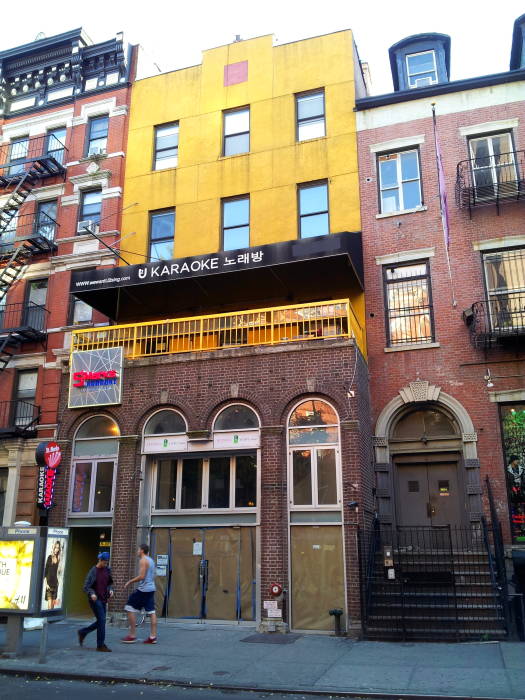
Berg, Hanson, and Caron collected dynamite and stored it in the apartment of Louise Berger, another Anarchist Black Cross member. Her apartment was on the sixth floor of a building at 1626 Lexington Avenue, between 102nd Street and 103rd Street in East Harlem. She left the apartment on the morning of 4 July 1914 just 15 minutes before the dynamite exploded.
The upper three floors of the building were wrecked, and the three central plotters were killed along with Marie Chavez, who was uninvolved in the plot and simply had the misfortune to have rented a bedroom in an apartment otherwise occupied by bomb-making anarchists. Furniture was thrown hundreds of feet through the air. Twenty other people were injured, seven of them hospitalized.
This apartment building now at 1626 Lexington Avenue is the one built in place of the one wrecked by the anarchists' bomb. Ελληνικη Ορθωδοξος Εκκλησια Αγιοι Γεωργιος και Δημητριος or the Hellenic Orthodox Church of Saints George and Demetrius is on its north side. It was originally built in 1891 as the Blinn Memorial Methodist Episcopal Church, it survived the explosion next door.

1626 Lexington Avenue, site of an apartment building largely destroyed by an anarchist bomb in 1914.

Other buildings in the neighborhood of the 1914 anarchist bomb explosion.
Another IWW member named "Mike" Murphy happened to have spent the night in the dangerous apartment and was still in bed when the dynamite exploded. The floor of the bedroom he was occupying was destroyed, and he rode the bed down to the next floor. He managed to walk away with minor injuries and the loss of some clothing. The police wanted to question him, but he managed to slip away. Berkman sent Murphy and Plunkett into hiding, with Murphy going to New Jersey, then into the care of the Radical Library group operating in Philadelphia, and eventually to Canada.
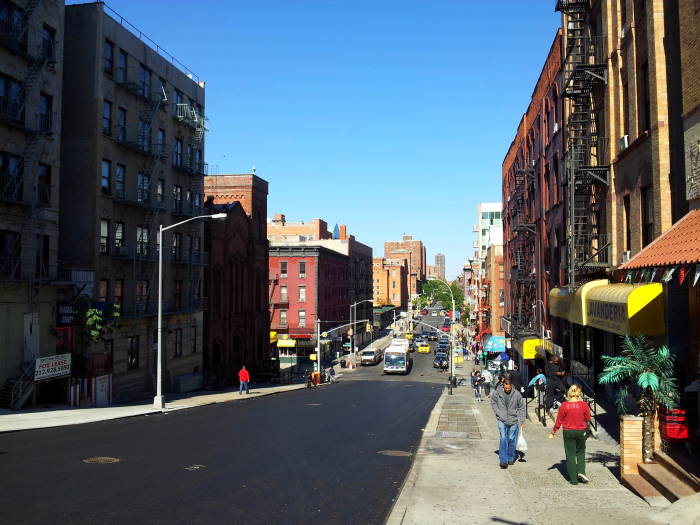
Other buildings in the neighborhood of the anarchist bomb explosion.
Los Angeles Times Bombing, 4 July 1914
The International Association of Bridge and Structural Iron Workers union was founded in 1886. The National Erectors' Association, an anti-union industrial association, was founded in response in 1903.
In late 1906 the national and local officials of the International Association of Bridge and Structural Iron Workers union began a campaign of dynamite bombing. Between late 1906 and 1911 the union had blown up 110 iron works.
The publisher of the Los Angeles Times was an outspoken anti-union crusader. In the early morning hours of 1 October 1910, a dynamite bomb hidden in a suitcase went off in an alley beside the Times building. The union had intended for their bomb to go off at 4 AM. But a faulty timer set off the 16 sticks of dynamite at 1:07 AM, when 115 staff members were working overnight on a special edition. The bomb collapsed the side of the building and broke open some natural gas pipelines running underneath the building. 21 of those staff members died in the ensuing fire.
The publisher naturally criticized the bombers as soon as an issue could be published, and the following morning unexploded bombs were found outside his home, at the home of the secretary of the anti-union merchants' association, at the Los Angeles County Hall of Records (being constructed by a non-union iron works), and at the Hotel Alexandria.
Preparedness Day Bombing, 22 July 1916
The city of San Francisco held a parade on July 22, 1916 to mark Preparedness Day, observing the imminent entry of the U.S. into World War I.
A bomb was detonated during the parade, killing ten people and seriously wounding forty. The bomb was built from a cast steel pipe filled with explosive, either TNT or dynamite, and metal slugs to serve as shrapnel in addition to the pipe casing.
Two labor leaders, Thomas Mooney and Warran K Billings, were convicted and sentenced to be executed by hanging. Two other labor leaders were acquitted. The two convicted men had their sentences commuted to life in prison, and both were pardoned in 1939 as evidence of perjury and false testimony had become clear. Now it's not clear just which of the many anarchist bombers of the period were involved.
Black Tom Explosion in New York Harbor, 30 July 1916
This was an act of sabotage by German agents, but the U.S. Directorate of Naval Intelligence found that they had some assistance from radical groups active in the U.S. including the Irish Clan na Gael group and the Indian Ghadar Party, both of whom were siding with Germany against England, plus some Communist elements.
Black Tom Island was next to Liberty Island in New York Harbor. Its owner, the Lehigh Valley Railroad, enlarged the island with landfill and built a causeway and rail line connecting it to the New Jersey mainland. It was a shipping depot with a mile-long pier and warehouses.
The island became a major munitions depot. Germany sent agents to the U.S. to sabotage production and shipping of munitions. Two German agents had obtained jobs as guards at the depot. About two million pounds of explosives and ammunition was stored there in barges and warehouses at the time of the attack.
The first and largest of the explosions happened at 2:08 AM on 30 July 1916. The explosion caused shaking equivalent to an earthquake between 5.0 and 5.5 on the Richter scale and awakened people as far away as Pennsylvania and Maryland. It threw fragments over a mile, damaging the Statue of Liberty and The Jersey Journal building's clock tower. The shock wave cracked the outer wall of City Hall in Jersey City and broke windows up to 25 miles away, including thousands in Lower Manhattan.
Further landfill has made the former island part of the mainland.
Galleani Anarchist Bombing Spree, April-June 1919
Luigi Galleani was an Italian anarchist active as an anarcho-communist and insurrectionary anarchist in the U.S. from 1901 to 1919. He advocated the "propaganda of the deed", violence to kill those he saw as "tyrants" and "oppressors" and lead to the overthrow of government institutions. His followers, the Galleanisti, carried out a series of assassination attempts and bomb attacks against persons and institutions they saw as "class enemies".
The Galleanisti bombing attacks began in 1914, with several bombings and attempted bombings in New York City at police stations, courthouses, and churches.
In 1916, a Galleanisti named Nestor Dondoglio worked as a chef in Chicago. He used arsenic to poison the soup served at a banquet to about 100 guests prominent in business, finance, and law. One of the guests happened to be a physician, who hastily prepared enough emetic to induce vomiting in all the guests. No one died, but you can imagine that it was an extremely unpleasant experience for all involved. Dondoglio fled to the East Coast under the alias Jean Crones and was hidden by other Galleanisti until his death in 1932.
In December 1916, Galleanisti in Boston stabbed a police officer during a riot, then exploded a bomb at a police station the following day.
In early 1917 Galleani advised his followers to relocate Mexico to avoid the military draft. Anarchist bombings largely stopped until they started returning later that year.
A large black powder bomb with an acid-based delay detonator was set off at a Milwaukee police station in November 1917, killing nine policemen plus a woman in the worst terrorist violence in the U.S. up to that date. In late 1917 and early 1918 there were also anarchist bombings in New York City, San Francisco, Washington, and Boston. In Philadelphia in December 1918, bombs filled with metal shrapnel heavily damaged the homes of the President of the Chamber of Commerce, the Acting Superintendent of Police, and a judge.
In late April of 1919, anarchists mailed about 36 dynamite based package bombs to the homes of a variety of politicians, justice officials including the U.S. Attorney General, and businessmen including John D. Rockefeller. One addressed to an investigator with the Bureau of Investigation, a precursor to the FBI, was discovered. The anarchists had not put adequate postage on any of the bomb packages, and they were all distinctively packaged allowing for most of the them to be intercepted before delivery.
Then, on the evening of June 2, 1919, the Galleanisti detonated eight large bombs almost simultaneously in eight U.S. cities. These were much larger than the April mail bombs, which had used one stick of dynamite each. These bombs used up to 11 kilograms of dynamite each and were wrapped with heavy metal slugs. Assistant Secretary of the Navy (and future President) Franklin Delano Roosevelt and his wife Eleanor lived across the street from one of the targets and had walked past his home just minutes before a bomb detonated early. It killed the would-be bomber, with parts of his body landing on the Roosevelt's doorstep. The large June bombs were all accompanied with several copies of a flyer:
War, Class war, and you were the first to wage it under the cover of the powerful institutions you call order, in the darkness of your laws. There will have to be bloodshed; we will not dodge; there will have to be murder: we will kill, because it is necessary; there will have to be destruction; we will destroy to rid the world of your tyrannical institutions.
Luigi Galleani and eight of his followers were deported to Italy in June 1919 after April and June's waves of bombings his Galleanisti had perpetrated.
1919 also saw the Seattle General Strike in January (60,000 workers in over 100 local unions); violence breaking out during May Day parades in Boston, New York, and Cleveland; race riots during the summer in Charleston, South Carolina, Washington, and Chicago; the Boston Police Strike in September; the Steel Strike of 1919 in September; the Centralia Massacre in November; and the Coal Strike of 1919 in November.
The continuing anarchist violence led Attorney General A. Mitchell Palmer's to direct what came to be called the Palmer Raids in November 1919 and January 1920. These were part of the "1919-1920 Red Scare", driven by the 1917 Communist Revolution in Russia. About 10,000 were arrested, 3,500 held in detention, and 556 resident aliens deported. Those arrested reported being threatened and beaten during the arrests and questioning. J. Edgar Hoover himself admitted that there were "clear cases of brutality." The anarchist bombing campaign went on for another twelve years. The last was in 1932, a bomb detonated at the home of Webster Thayer, the presiding judge at the trial of Sacco and Vanzetti. It destroyed the home and injured his wife and housekeeper.
The violence wasn't limited to anarchists and their dynamite bombs. The Coal Wars were a series of armed labor conflicts running roughly from 1890 to 1930. Among others these included:
- Lattimer Massacre (1897) in Pennsylvania, 19 striking coal miners were shot and killed by a sheriff's posse.
- Pana Massacre (1899) in Illinois combined labor violence with a race riot, killing seven. This was part of the Illinois Coal Wars of 1898-1900, in which about 24 were killed.
- Colorado Labor Wars (1903-1904) between Western Federation of Miners and the mine operators. The mine operators had armed support from the Colorado National Guard plus private contractors including the Pinkerton, Baldwin-Felts, and Thiel detective agencies.
- Colorado Coalfield War (1913-1914) built up to the Ludlow Strike, which ended with the Colorado National Guard attacking a tent city occupied by striking coal miners. 69 to 199 people were killed in that massacre and the following violence.
- Anaconda Road Massacre (1920) was when guards of the Anaconda Copper Mining Company fired on striking miners in Montana, killing one and injuring sixteen others.
- Hanapēpē Massacre (1924) in which police fought armed striking Filipino sugar workers, with sixteen strikers and three policement killed.
- Columbine Mine Massacre (1927) in which machine guns were used by either the state police or mine guards against a group of striking coal miners, killing six.
- Harlan County War (1931-1939) with armed battles, executions, and bombings in Kentucky, leading to an unknown number of deaths.
Wall Street Bombing, 16 September 1920
Anarchists exploded a bomb at noon on a working day on Wall Street, killing 38 people and injuring hundreds, 143 of them seriously. This was the deadliest act of terrorism in the U.S. up to this point, exceeding the death toll of the Los Angeles Times bombing in 1910.
The bomb was timed to explode at noon in order to maximize fatalities and injuries. This time the anarchists managed to assemble a nearly perfect system. The picture here shows the immediate aftermath. It has long been assumed that Galleanisti anarchists were behind it and specific men were suspected, but the crime has never been definitively solved.
Someone drove a horse-drawn wagon into place across Wall Street from 23 Wall Street, the headquarters of the J.P. Morgan bank, diagonally opposite the New York Stock Exchange and adjacent to Federal Hall.
The driver seems to have left the wagon and escaped to safety. A timer detonated the bomb at 12:01 PM, when Wall Street was crowded with financial workers out to get their lunch. The bomb contained 100 pounds of dynamite surrounded by 500 pounds of cast-iron window sash weights, creating deadly shrapnel.
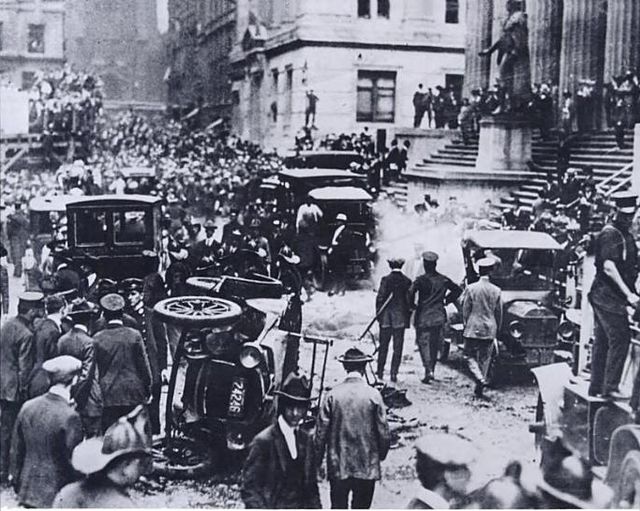

30 people were killed immediately, and 8 more died shortly thereafter. 143 people survived with severe injuries, several hundred more were injured in some way. Most of those killed and injured were young workers — clerks, brokers, stenographers, and messengers. These weren't the financial leaders hated and targeted by the anarchists.
Compare this to the two bomb explosions at the 2013 Boston Marathon in which only three people were killed.
The J.P. Morgan Bank building at 23 Wall Street, seen in the first picture here, was severely damaged. The blast blew in most of the windows and largely destroyed much of the interior. The total property damage was estimated at $2 million at the time, equivalent to about $23.5 million today.

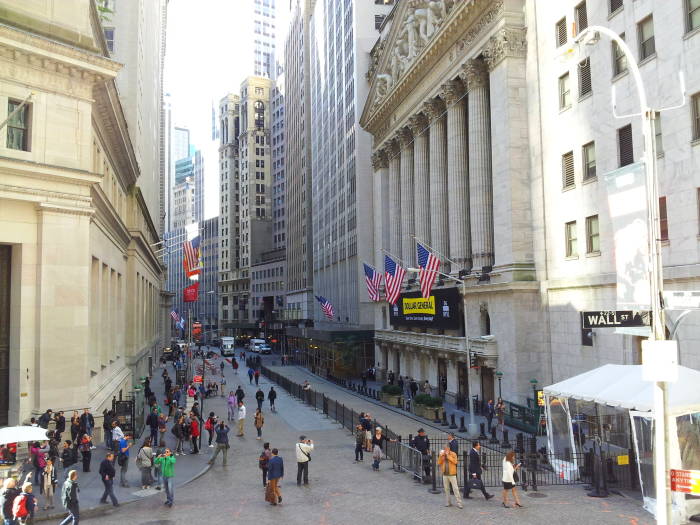
The pictures above were taken from the top of the steps of Federal Hall. In the first, Wall Street angles off to the left and Broad Street to the right. The second picture looks down Broad Street with the J.P. Morgan Bank building at left and the New York Stock Exchange at right.
Below you see the damage still visible today on the exterior of the former J.P. Morgan Bank building at 23 Wall Street. The company announced at the time that it would never repair the damage to defy the criminals.
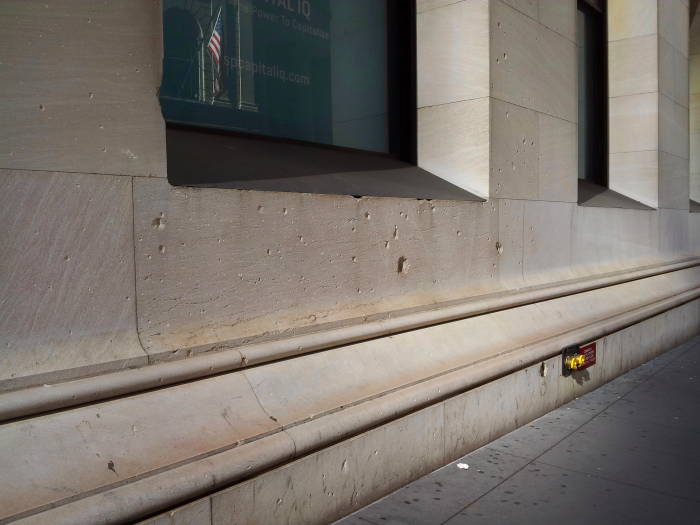
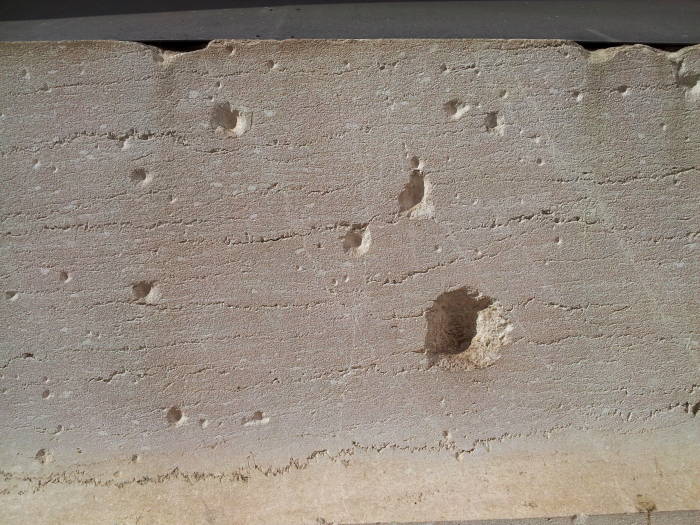
The building was sold in 2003 to a joint venture of Africa Israel Investments Ltd. and the real estate developer Shaya Boymelgreen. It along with the adjacent 42-story tower at 15 Broad Street became a condominium development called Downtown by Philippe Starck. It was sold in 2008 to a partnership of the Hong-Kong-based China International Fund and the Sonangol Group oil and gas organization based in Angola.
Beverly Gage's The Day Wall Street Exploded describes the Wall Street bombing and its whole bomb-plagued era in detail.
Dashiell Hammett's novel Red Harvest was based on the Anaconda Road Massacre in Montana five months before the Wall Street Bombing. Hammett was a detective for the Pinkerton agency.
Amazon
ASIN: B007MXHCJU
Amazon
ASIN: 0679722610
In 1917 the Pinkerton Agency had sent Hammett and other operatives to Montana to infiltrate the mining union. Members of the International Workers of the World were there organizing a strike. Hammett and other Pinkerton operatives were offered $5,000 to help assassinate Frank Little, an IWW organizer. Hammett turned that down, but someone else beat and hanged Frank Little from a railroad trestle.
Hammett's experiences and observations in strike-breaking operations with Pinkerton led to his disillusionment with this sort of detective work and intensified his leftist political views. He joined the Communist Party USA in 1937.
Hammett's 1934 novel The Thin Man features the detective Nick Charles as the author's stand-in. The character says that he worked on the 1920 bombing case.
Amazon
ASIN: 0679722637
Amazon
ASIN: B000K0YM0Y
Akira Kurosawa made the classic samurai movie Yojimbo in 1961. In 1964, Sergio Leone made A Fistful of Dollars as basically a remake of Yojimbo. Supposedly someone came to Kurosawa when A Fistful of Dollars was about to be released, warning him that his film had been remade without any rights being secured. Then Kurosawa responded that it didn't really matter, as he had based Yojimbo on Hammett's novel Red Harvest without seeking any rights or acknowledging where its story came from.
Back to the 1920 Wall Street Bombing:
The New York Stock Exchange suspended trading within one minute of the explosion, to prevent a panic leading to severe market deviation. By 3:30 PM, the NYSE board of governors had decided to open trading the next day.
There was no clear link to any group, and the police initially thought it might have been some sort of an accident. Evidence was lost when the area was cleaned overnight to open the businesses the following day.
The following day the U.S. Justice Department's Bureau Of Investigation or BOI, which later became the FBI, released a bundle of flyers that had been found in a post office box in the Wall Street area just before the explosion. They were printed in red ink and said "Remember, we will not tolerate any longer. Free the political prisoners, or it will be sure death for all of you." The fliers were signed "American Anarchist Fighters". The NYPD and BOI started investigating anarchist and communist groups. The governmental investigation continued for three years without success.
Almost nothing could be found of the horse and wagon, but the horse's iron shoes were found. They showed that the horse had been newly shod, but when the blacksmith was located in October he could provide very little information.
A tennis champion named Edwin Fischer had sent post cards to his friends telling them to leave the area before September 16. But when police investigated, he told them that he had received the information "through the air" and they found that he regularly issued these types of warnings. Send enough such warnings often enough, and eventually you will happen to at least come close getting it right. Fischer ended up in Amityville Asylum, diagnosed as insane but basically harmless.
Many historians believe that Mario Buda, an associate of the Italian anarchists Sacco and Vanzetti, was most likely the driver who planted and armed the wagon-bomb and then escaped before it exploded.
Large-scale U.S. government surveillance of its citizens and the imprisonment without charge of suspicious foreigners started in this era. J. Edgar Hoover began his Justice Department career in its War Emergency Division. He became the head of its Alien Enemy Bureau and was authorized by President Woodrow Wilson to arrest and jail disloyal foreigners without trial. In 1919 he became head of its new General Intelligence Division, also called the Radical Division, monitoring and disrupting domestic radicals. U.S. government domestic surveillance underwent a huge increase and has never been dialed back.
The surveillance continues, gathering more and more data as technology advances. A former U.S. State Department staff member wrote in the Washington Post in 2014 that Ronald Reagan's Executive Order 12333 from December, 1981, is worse than the Patriot Act. All the NSA has to do is traffic shaping, manipulation of Internet routing done normally to balance traffic loads, and E.O. 12333 lets them sample all content of traffic between two Americans under no formal surveillance or suspicion. Being an American and communicating is itself suspicious enough.
Or, being an American and sending or receiving mail. The U.S. Postal Service photographs every piece of mail using the Mail Isolation Control and Tracking system.
Weather Underground, 6 March 1970
Bombs continued to be hazardous things for amateurs to assemble in Manhattan apartments. In 1970, members of the Weather Underground were assembling a dynamite bomb in a four-story townhouse at 18 West 11th Street in the Greenwich Village area. There had been long arguments about which targets to attack, one being a dance for non-commissioned officers and their dates at Fort Dix in New Jersey ("to bring the Vietnam War home" as the militants put it), another being Columbia University's main library.
They had obtained quite a bit of dynamite, much more than enough to reduce the four-story townhouse to burning rubble. None of them had any experience with explosives, and some lacked the most basic knowledge of electricity. Slightly less clueless members put together a very simple fusing circuit with no safety features, just a clock, a battery, and a blasting cap, and they started packing dynamite and roofing nails into one-foot lengths of iron water pipe.
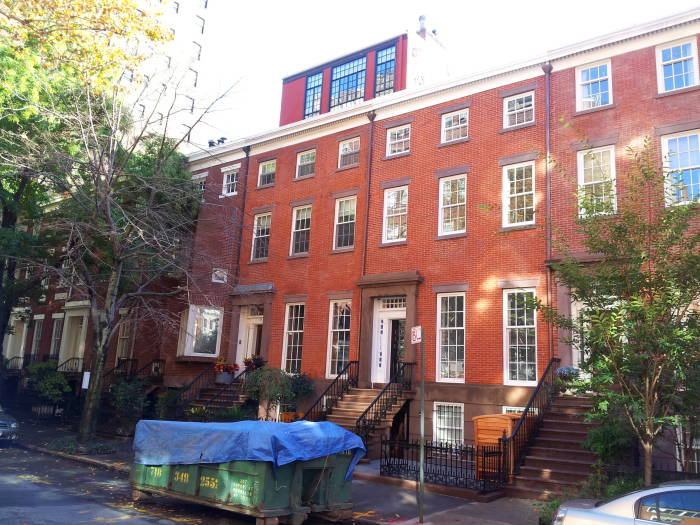
18 West 11th Street is the townhouse with angled front behind the left end of the blue-tarp-covered dumpster.
Some of the bombs went off in the basement workshop, instantly killing the two members assembling the bombs. Another member happened to be returning to the townhouse at that moment and was killed when the building's façade collapsed on him. Two other members were upstairs at the time and survived, despite having most to all of their clothing stripped from their bodies in the explosion. Gas lines broken by the explosion led to a fire.
A search of the rubble turned up even more explosives that hadn't gone off in the main blast or following fire — 57 unused sticks of dynamite, four finished 12-inch pipe bombs packed with dynamite and nails, and a 37-mm antitank shell from 1916.
The replacement building was built in a modern style with a triangular offset front.
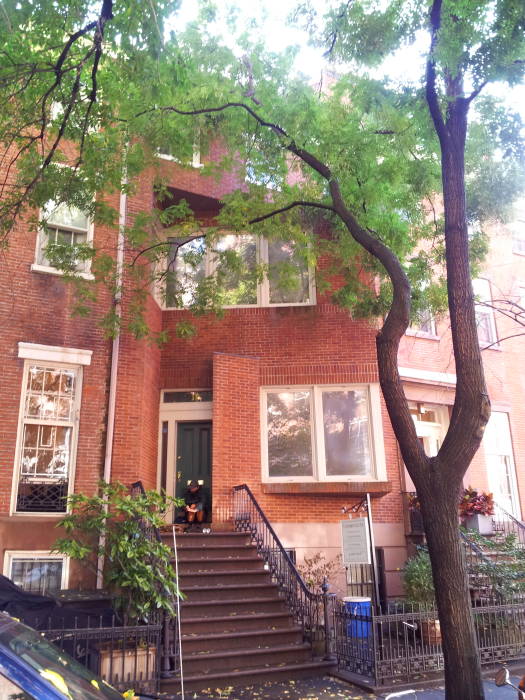
Puerto Rican Nationalists in the 1970s
The extremist Puerto Rican nationalist group FALN or Fuerzas Armadas de Liberación Nacional Puertorriqueña (Armed Forces of Puerto Rican National Liberation) set off several bombs in New York in the 1970s.
| 11 December 1974 | 336 East 110th Street in East Harlem |
| 24 January 1975 | Fraunces Tavern in the Financial District, about 10 pounds of dynamite in an attaché case |
| 3 April 1975 | Four bombs in a 40-minute period:
|
| 3 August 1977 | Two bombs:
|
| 8 August 1977 | Bomb found and defused before exploding in the AMAX building at 1270 Avenue of the Americas |
Back to the Travel Recommendations